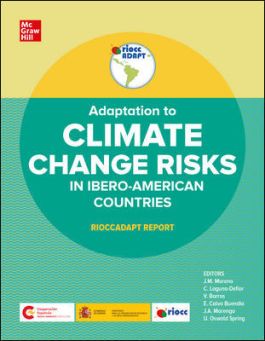Adaptation to Climate Change Risks in Ibero-American Countries
Official presentation.
Summary for Policymakers (Spanish).
Summary forPolicymakers (Portuguese)
1.Conceptual framework and regional context. 2. Society, governance, inequity and adaptation. 3. Inland terrestrial and aquatic ecosystems. 4.Marine-coastal ecosystems. 5. Biodiversity. 6. Water resources. 7.Agricultural resources. 8. Fishery resources. 9. Storms and hurricanes. 10. Floods and droughts. 11. Slope instability and land slides. 12. Forest fires. 13. Urban and rural settlements. 14. Coastal areas. 15. Tourism. 16. Human health.
Annex I. Glossary.
Annex II. Authors, reviewers, steering committee and monitoring commission of the RIOCCADAPT project.
To read and download separate chapters of this book, please, go to http://rioccadapt.com/en/
RIOCCADAPT is an international project financed by the ARAUCLIMA program of the Spanish Agency for Development Cooperation, and coordinated by the University of Castilla-La Mancha. The goal of the project has been to produce the RIOCCADAPT Report, in which the actions of adaptation to climate change that the countries of the Ibero-American Network of ClimateChange Offices (RIOCC) have been carrying out have been evaluated, as well as their vulnerabilities and risks.
The high exposure of the region to risks derived from climate change has made adaptation to it a priority area of ??work for the RIOCC. The RIOCCADAPT Report has been drafted by a multidisciplinary team of more than a hundred academics and researchers from all the RIOCC countries. The report has focused on the main natural, terrestrial, inland aquatic or coastal marine ecosystems, biodiversity, water, fishing or agricultural resources, the risks of extreme meteorological or climatic events, such as hurricanes, storms, droughts, floods, landslides slopes, and aspects more closely related to human populations, their settlements, coastal areas and health, as well as the tourism industry. The text is intended to serve as a reference for institutions responsible for climate and environmental governance, as well as development non-governmental organizations or the general public in Ibero-American countries.

